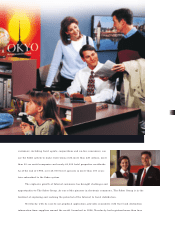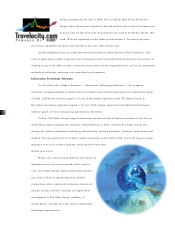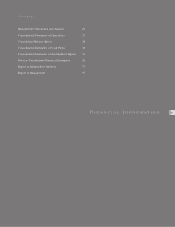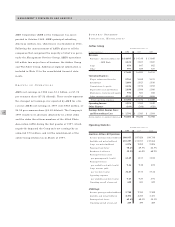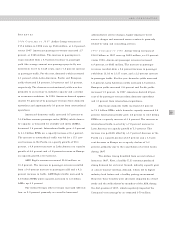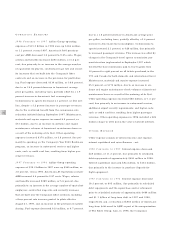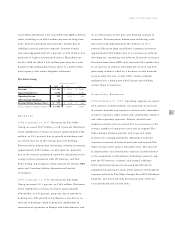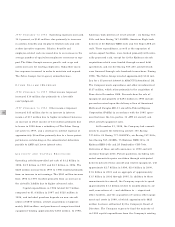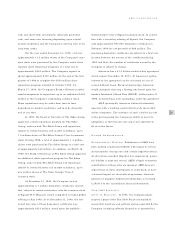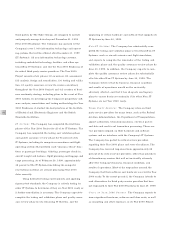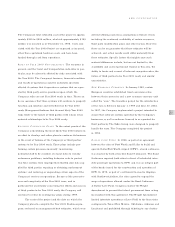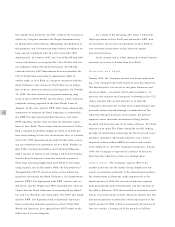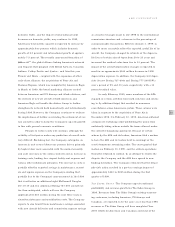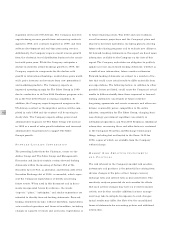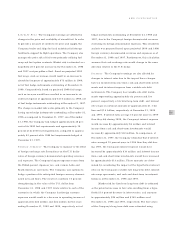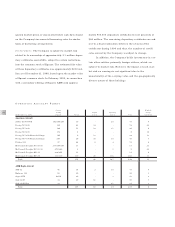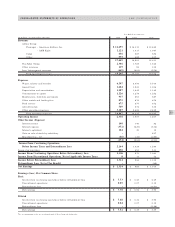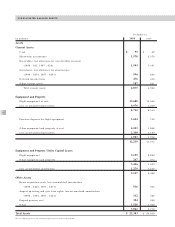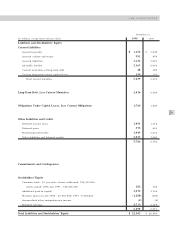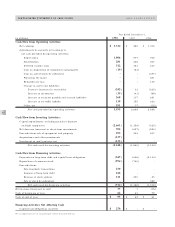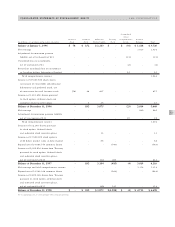American Airlines 1998 Annual Report Download - page 33
Download and view the complete annual report
Please find page 33 of the 1998 American Airlines annual report below. You can navigate through the pages in the report by either clicking on the pages listed below, or by using the keyword search tool below to find specific information within the annual report.
31
The Company’s total estimated cost of the project is approx-
imately $215 to $250 million, of which approximately $180
million was incurred as of December 31, 1998. Costs asso-
ciated with the Year 2000 Project are expensed as incurred,
other than capitalized hardware costs, and have been
funded through cash from operations.
RISKS OF YEAR 2000 NON-READINESS The economy in
general, and the travel and transportation industries in par-
ticular, may be adversely affected by risks associated with
the Year 2000. The Company’s business, financial condition
and results of operations could be materially adversely
affected if systems that it operates or systems that are oper-
ated by third party service providers upon which the
Company relies are not Year 2000 ready in time. There can
be no assurance that these systems will continue to properly
function and interface and will otherwise be Year 2000
ready. Management believes that its most likely Year 2000
risks relate to the failure of third parties with whom it has
material relationships to be Year 2000 ready.
BUSINESS CONTINUITY PLANS To the extent practical, the
Company is identifying the most likely Year 2000 failures in
an effort to develop and refine plans to continue its business
in the event of failures of the Company’s or third parties’
systems to be Year 2000 ready. These plans include per-
forming certain processes manually; maintaining
dedicated staff to be available at crucial dates to remedy
unforeseen problems; installing defensive code to protect
real-time systems from improperly formatted date data sup-
plied by third parties; repairing or obtaining replacement
systems; and reducing or suspending certain aspects of the
Company’s services or operations. Because of the pervasive-
ness and complexity of the Year 2000 issue, and in
particular the uncertainty concerning the efforts and success
of third parties to be Year 2000 ready, the Company will
continue to refine its contingency plans during 1999.
The costs of the project and the date on which the
Company plans to complete the Year 2000 Readiness pro-
gram are based on management’s best estimates, which were
derived utilizing numerous assumptions of future events
including the continued availability of certain resources,
third party modification plans and other factors. However,
there can be no guarantee that these estimates will be
achieved, and actual results could differ materially from
these estimates. Specific factors that might cause such
material differences include, but are not limited to, the
availability and cost of personnel trained in this area, the
ability to locate and correct all relevant computer codes, the
failure of third parties to be Year 2000 ready and similar
uncertainties.
NEW EUROPEAN CURRENCY In January 1999, certain
European countries established fixed conversion rates
between their currencies and a new common currency unit
called the “euro”. The transition period for the introduction
of the euro is between January 1, 1999 and June 30, 2002.
In 1997, the Company implemented a project intended to
ensure that software systems operated by the Company’s
businesses as well as software licensed to or operated for
third parties by The Sabre Group were designed to properly
handle the euro. The Company completed the project
in 1998.
DALLAS LOVE FIELD In 1968, as part of an agreement
between the cities of Fort Worth and Dallas to build and
operate Dallas/Fort Worth Airport (DFW), a bond ordinance
was enacted by both cities (the Bond Ordinance). The Bond
Ordinance required both cities to direct all scheduled inter-
state passenger operations to DFW and was an integral part
of the bonds issued for the construction and operation of
DFW. In 1979, as part of a settlement to resolve litigation
with Southwest Airlines, the cities agreed to expand the
scope of operations allowed under the Bond Ordinance
at Dallas’ Love Field. Congress enacted the Wright
Amendment to prevent the federal government from acting
inconsistent with this agreement. The Wright Amendment
limited interstate operations at Love Field to the four states
contiguous to Texas (New Mexico, Oklahoma, Arkansas and
Louisiana) and prohibited through ticketing to any destina-
AMR CORPORATION


